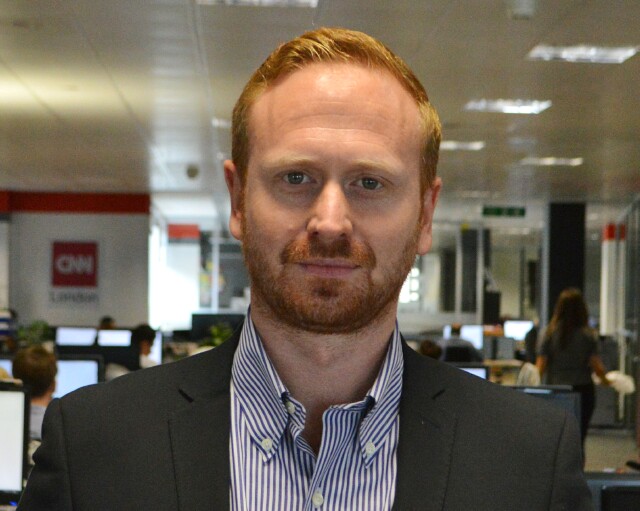CNN + the Pangaea Alliance: Quality Programmatic at Global Scale

CNN International, The Economist, Financial Times, The Guardian and Reuters -- a group of select business brands with a massive global audience -- have recently joined forces to create the Pangaea Alliance on the Rubicon Project advertising automation cloud. In the second part of a two-part series, Jay Sears, Senior Vice President Marketplace Development at Rubicon Project recently discussed advertising automation and the rationale for Pangaea with Robert Bradley of CNN International.
Be sure to read Part One in this series, Jay’s interview withShane Cunningham of Reuters.
Your Name:Robert Bradley
Your Company:CNN International
Your Title:Director, Digital Ad Revenue and Data
JAY SEARS: What do you read to keep up with politics, art and culture?
ROBERT BRADLEY: Working for CNN means my day is filled with such content but in my spare time I also enjoy the Economist, Quartz, Artspace for art and the Londonist, a great emailer about what’s on in London.
SEARS: What do you read to keep up with friends?
BRADLEY: Interesting question. It could be taken as what do I read to ensure I have intelligent conversation when I meet friends? Is it asking that? In which case naturally Tolstoy, Oscar Wilde and the complete works of Shakespeare. But, sadly I can’t help but think of Facebook.
SEARS: What do you read to keep up with our industry?
BRADLEY: I am a big fan of The Drum -- great content with a unique tone. M&M and Campaign are also good.
SEARS: What’s your favorite commercial of all time?
BRADLEY: I wasn’t around at the time but Ogilvy’s infamous The Man in the Hathaway Shirt ad changed the industry and the way we associate brands with creative and ads. I’ll go with that.
SEARS: With regards to advertising automation and programmatic, what are CNN’s three biggest company-wide initiatives for the remainder of 2015 and into 2016?
BRADLEY:
1. We really do want to get a point of true dynamic allocation -- serving each ad, regardless of format or platform, to the highest buyer from a mix of demand sources.
2. As CNN is essentially a video first company, programmatic video is important to gain the fill of our vast volume of video inventory. We are committed to remaining at the premium end of the business so working with the right mix of demand is important.
3. High impact programmatic is also important to us and the industry for automation to grow.
SEARS: What was the rationale for CNN joining the Pangaea cooperative? What is the opportunity?
BRADLEY:As a media owner we now have more competitors than ever before. They could be a data company, a trading desk or one of the very big digital players. Many of these companies target ads across borders for their clients and have huge scale. However, most don’t create incredible premium content. The alliance combines great scale with great content and audience insight that provides a very brand-safe platform to match huge scale.
SEARS: Who are the members of Pangaea? What is the criteria, how long was it in formation and do you imagine the expansion of its membership?
BRADLEY: The members are all at the premium end and have a very long tradition of providing our consumers with very high quality content throughout the world. Members need to be forward thinking and open to thinking differently. Currently CNN International, Financial Times, the Guardian, Reuters and the Economist are in the alliance.
SEARS: What is the current state or the near term plan to integrate Pangaea into CNN’s sales and operations?
BRADLEY:We are still in the second Beta phase of Pangaea so there is work to be done as we find out more about how it fits in our own strategy, in market and against our competitors. What we have discovered is there is a thirst for the alliance from the demand side, which is naturally key to the success. It’s important that Pangaea is a clearly defined product that differs from our own direct solutions.
SEARS: Ad automation/programmatic has been used smartly as the “tip of the spear” (a lead strategy) for entry into global markets. Have you pursued this strategy independently? And does Pangaea contribute to this strategy?
BRADLEY:CNN is long established as one of only a handful of truly global platforms that offers a single cross-platform buying point across the world to our advertisers. Programmatic and Pangaea is seen as part of the mix. It also ensures we are part of today’s market and embracing new routes to market rather than resisting them. Success in a rapidly evolving market is dependent on having open eyes and moving quickly in a changing market, combined with the ability to stop doing what isn’t working quickly, whatever the investment, and focus on what is.
SEARS: At CNN International, on average companywide globally -- out of each $1.00 spent on media (all media, not just digital) by one of your advertisers, how much today (in 2015) is spent on automated or programmatic channels?
BRADLEY:I would suggest we are at around 20-30% of our digital inventory being bought programmatically. This is high considering markets such as LATAM and Africa still haven’t fully embraced programmatic and we have big footprints in these regions.
SEARS: What will this number be in 2017?
BRADLEY: 50% minimum
SEARS: Tell us the about the global advertising operations of CNN.
BRADLEY: CNN International reaches hundreds of millions of users globally across a range of international products and major verticals. Programmatic has only added to the efficiency we already offer to brands and agencies that wish to target global audiences in premium environments. The fact we have an in house creative agency and a smart cross-platform data strategy amplifies this.
SEARS: How many employees are there in your ad automation/programmatic organization?
BRADLEY: We have well over 100 people as we don’t silo programmatic. We have specialists but encourage all the global commercial team to embrace, sell and be involved in programmatic. This extends when you include operations, product and support functions such as comms, marketing, our in house creative agency. It’s a company-wide subject that the whole business needs to be aware of and embrace.
SEARS: Tell us your view -- draw an analogy between the automation of television and a European football game. Are we in the pre-game? Still driving to the stadium?
BRADLEY:Pre-game and in training. A key player recently told me only a few tens of millions of dollars have been spent programmatically on TV at the moment. Even if it’s a few hundreds of millions it’s still tiny compared to what will come. US is leading but Western Europe and Australia aren’t far behind.
SEARS: Can linear TV be automated, yes or no?
BRADLEY:TV is already digital and the technicalities of automating ad buying aren’t difficult I am led to believe. I don’t think it’s a case of "can." It’s a case of "when," and it’s already happening on a tiny scale.
SEARS: Which of the following will accelerate the automation of site direct (direct orders) budget? Pick all that apply:
a) Dynamic access to all publisher inventory [vs. just “remnant” or “auction”]
b) Ability to leverage publisher first party data
c) Ability to leverage advertiser first party data [against all publisher inventory, especially premium]
d) Availability of rich media, expandable units and larger IAB Rising Star formats
e) Ability to more easily curate audiences for specific advertisers across the premium content of multiple publishers
f) All of the above
BRADLEY:All of the above but I feel there is a big gap in the market at point C at the moment.
SEARS: If you could go to the airport right now with friends or family and fly anywhere in the world for vacation, who would you take and where would you go?
BRADLEY:Well, I am writing this from an airport! Only thing missing are the friends and the family, which would definitely be nice at the end of this long journey. I would go to Thailand and to Krabi. The food, the people, the beaches are all unbeatable.
SEARS: If you could create an endowment to fund any existing non-profit you designated, what lucky non-profit organization would that be?
BRADLEY:Hard question as so many would deserve it. I am fond of Shelter, the UK-based charity for the homeless. I find it tough to take that in; with all the wealth in the world people still live on the streets or without a roof over their head regardless of their situation. The homeless are often misunderstood and forgotten about.
SEARS: What is your favorite restaurant in the world?
BRADLEY:One of my favorite films is “Lost in Translation” and Bill Murray is a hero. Eating in the New York Grill at the Park Hyatt where it was filmed in Tokyo is hard to beat even if just for the views.
SEARS: Thanks, Rob!
The opinions and points of view expressed in this commentary are exclusively the views of the author and do not necessarily represent the views of MediaVillage/MyersBizNet management or associated bloggers.


